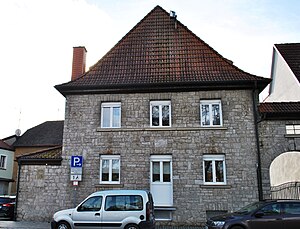Bridge Mill (Volkach)
| Bridge mill
|
||
|---|---|---|
| Location and history | ||
|
|
||
| Coordinates | 49 ° 52 '3 " N , 10 ° 13' 30" E | |
| Location |
|
|
| Waters | Volkach | |
| Built | First mentioned in 1429 | |
| Shut down | Sixties of the 20th century | |
| Status | Mill technology removed and building converted | |
| technology | ||
| use | Flour mill | |
| drive | Watermill | |
The bridge mill (also Untere Mühle, Niedere Mühle, Mühle uff der Brücken, Klüpfelsmühle) is a former grain mill in Volkach, Lower Franconia . It is located on the Volkachbach outside the medieval old town at the Unteren Tor and has been used as a residential building since the 1960s.
history
The bridge mill is the second oldest mill in the Volkach city area after the Schaubmühle . The Schaubmühle was first mentioned in 1375 as the “Upper Mill”. It can therefore be assumed that a second mill, the "Lower Mill", existed in the city at that time. However, the mill was only mentioned in a document in 1429 as “on the bridges”. The fishermen in the lower suburbs complained because the miller was decimating their catch with his traps .
After the population grew rapidly in the 16th century, food consumption also skyrocketed. This led to disputes between the millers in Volkach and Obervolkach . The reason was the use of the energy of the water. The increasing consumption of food led to the construction of a town mill towards the end of the century, which was supported by the authorities. The manor mill was subsidized by the city council , so the bridge mill was exposed to competition.
In contrast to the Schaubmühle, the names of the owners and tenants of the bridge mill are only incomplete. On July 3, 1714, Andreas Jenelein was the owner of the mill, and in 1808 Sebastian Jäcklein is proven to be the leaseholder of the bridge mill. It is unclear whether Sebastian Baumann, mentioned on April 28, 1857, was sitting there. At the turn of the 20th century, a miller weaver ran the bridge mill.
In 1910 Robert Klüpfel bought the mill and moved into a residential building to the right of the Lower Gate. At first he kept the traditional grinding technique before a fire in 1930 forced him to replace the grinder. After Robert Klüpfel's death in the 1960s, the mill was shut down. The buyer Hermann Arndt set up a canning factory there. Today only a sandstone relief , classified as a monument, reminds of the former mill.
technology
The technology of the bridge mill changed only marginally between the Middle Ages and the early modern period . Even with the lifting of the compulsory mill, the mill technology of the mill was not renewed. The water inflow was still dependent on the climate. The standstill in technical innovations was also exacerbated by the fact that the Main mills in the area could not work in the first half of the 19th century due to the low water level. In 1830 the bridge mill had two grinding cycles .
See also
literature
- Ute Feuerbach: Water use in ancient times: the grain mills in Volkach . In: Ute Feuerbach (Ed.): Our Main Loop. 1993-2007 . Volkach 2008. pp. 329-338.
- Erika Stadler: On the trail of Volkach's town mills . In: Ute Feuerbach (Ed.): Our Main Loop. 1978-1992 . Volkach 2008. pp. 279-291.

